- China
- RealEcon
- Topics
-
Regions
Featured
-
Explainers
Featured
Interactive by Olivia Angelino, Thomas J. Bollyky, Elle Ruggiero and Isabella Turilli February 1, 2023 Global Health Program
- Research & Analysis
-
Communities
Featured
Webinar with Carolyn Kissane and Irina A. Faskianos April 12, 2023
-
Events
Featured
Virtual Event with Emma M. Ashford, Michael R. Carpenter, Camille Grand, Thomas Wright, Liana Fix and Charles A. Kupchan June 25, 2024 Europe Program
- Related Sites
- More
U.S.-Russia Nuclear Arms Control
The nuclear arms race was perhaps the most alarming feature of the Cold War competition between the United States and Soviet Union. Over the decades, the two sides signed various arms control agreements as a means to manage their rivalry and limit the risk of nuclear war. However, deep fissures have reemerged in the U.S.-Russia relationship in recent years, raising once again the specter of a nuclear arms race.




Dawn of the Nuclear Weapons Age

On July 16, U.S. military researchers conduct the world’s first atomic weapons test in Los Alamos, New Mexico, a culmination of the top-secret Manhattan Project. Days later, U.S. President Harry Truman informs Soviet leader Joseph Stalin of his plans to use an atomic weapon on Japan. In early August, American warplanes drop atomic bombs on Hiroshima and Nagasaki, killing more than one hundred thousand Japanese people. Many more would later die from related injuries or illnesses. The devastation helps compel Japan’s surrender in World War II and demonstrates the staggering power of a new class of weapons.
First Soviet Nuclear Test

The Soviet Union explodes its first nuclear weapon at a test range in Kazakhstan. Most U.S. intelligence assessments at the time had estimated that Moscow was at least three years away from obtaining such technology.
The Next Generation of Bombs

As their geopolitical rivalry heats up, the United States and Soviet Union race to develop the next class of weapons, known as thermonuclear, or hydrogen, bombs. In late 1952, U.S. scientists detonate the first of these weapons at an atoll in the Marshall Islands, an explosion hundreds of times more powerful than the bomb dropped on Hiroshima. (Weeks earlier, the United Kingdom tested its first nuclear weapon.) During another U.S. test in 1954, known as Castle Bravo, scientists badly miscalculate the yield, creating a radioactive fallout that harms many Marshall Islands inhabitants. The Soviet Union tests its first thermonuclear device in November 1955. Soviet testing also produces devastating health effects on nearby residents in Kazakhstan.
IAEA Established

The International Atomic Energy Agency (IAEA) is established in Vienna as a forum for international cooperation on civilian nuclear research. U.S. President Dwight D. Eisenhower first called for the creation of a such an agency in his Atoms for Peace speech to the UN General Assembly in 1953. Unanimously approved by more than eighty countries, the IAEA’s charter outlines a three-part mission: nuclear verification and security, safety, and technology transfer. The IAEA’s first safeguards for civilian nuclear facilities are established in 1961.
Sputnik Kicks Off Space and Missile Race
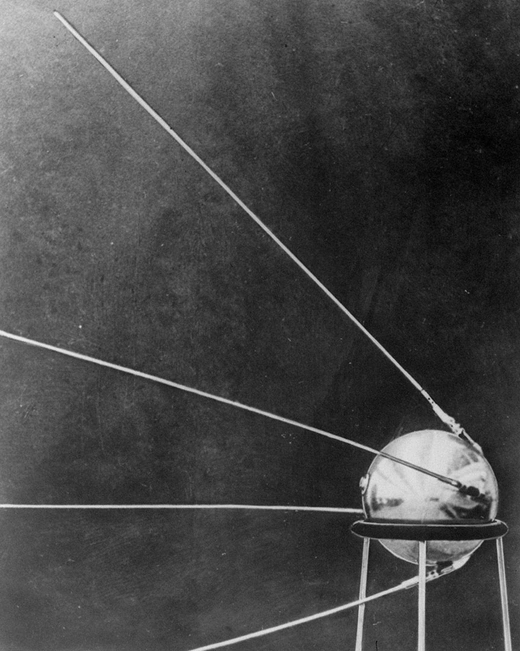
The Soviet Union conducts the world’s first successful test of an intercontinental ballistic missile (ICBM), seen as capable of striking U.S. territory, in October 1957. Days later, a modified version of the rocket launches Sputnik 1, the first man-made satellite, into orbit. The Soviets’ rapid technical achievements startle U.S. leaders, raising the specter of a first strike and the militarization of space. The Atlas missile program in United States conducts its first full-range ICBM flight in late 1958, the same year Washington creates NASA, a civilian space exploration agency.
Testing Boom

The year 1958 proves to be the most active to date for nuclear testing, with the Soviet Union, the United Kingdom, and the United States detonating more than one hundred devices in total. The three countries then voluntarily pause testing for several years as they discuss a permanent testing ban. In early 1960, France conducts its first test, becoming the world’s fourth nuclear power.
Cuban Missile Crisis
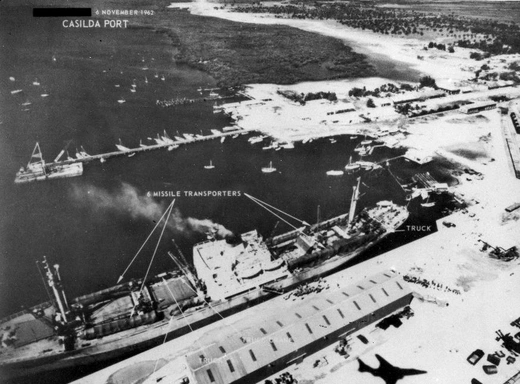
Cold War tensions nearly spill over into a nuclear conflict when, in October, U.S. reconnaissance flights reveal the Soviets constructing secret missile bases in Cuba. President John F. Kennedy warns Moscow of a “full retaliatory response” if it launches a nuclear attack from Cuba on any country in the Western Hemisphere. After a thirteen-day standoff between the superpowers, which includes a U.S. naval quarantine of Cuba, the Soviet Union agrees to withdraw its missiles. In exchange, the United States publicly pledges not to invade Cuba and, confidentially, agrees to pull its nuclear missiles out of Turkey.
Limited Test Ban Treaty
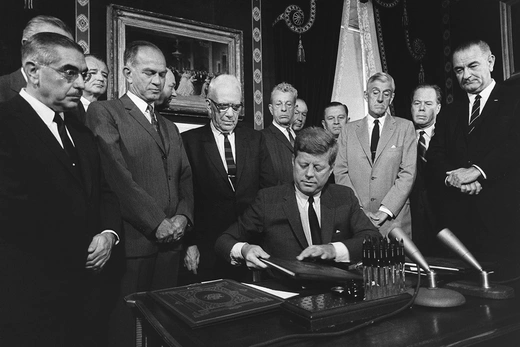
After years of on-again, off-again negotiations, the Soviet Union, the United Kingdom, and the United States agree to ban nuclear explosions in the atmosphere, outer space, and under water, and to significantly restrict underground testing. The Limited Test Ban Treaty reflects growing international concerns about the dangers of a nuclear fallout. A high-speed “hotline” connecting the leaders of the Soviet and U.S. governments is established to mitigate the risk of accidental warfare. France and China, which would become the world’s fifth nuclear power the following year, are not party to the treaty.
A Nonproliferation Victory
The pursuit of nuclear weapons by more states leads to calls for an international framework to halt proliferation. Discussions on a treaty began at the United Nations in 1959. After multiple drafts, the Soviet Union, the United Kingdom, and the United States sign the Treaty on the Nonproliferation of Nuclear Weapons (NPT) on July 1, 1968, agreeing to pursue general disarmament. China and France do not join until 1992. The nonnuclear signatories pledge to forgo the acquisition of nuclear weapons. Today, 190 countries are party to the NPT, making it the most widely adhered-to arms control agreement. Only India, Israel, North Korea, Pakistan, and South Sudan remain outside the treaty—the first four of which possess or are suspected to possess nuclear weapons.
Détente

The late 1960s and early 1970s see a general thawing of U.S.-Soviet relations, ushering in a hopeful era of nuclear arms control, which becomes most apparent in the Strategic Arms Limitation Talks, or SALT. The two sides forge a pair of groundbreaking agreements in 1972: the Anti-Ballistic Missile (ABM) Treaty limits the countries’ deployment of missile defense systems to their national capital and one ICBM site, and SALT I, which restricts their number of nuclear missile silos and submarine-launched missile tubes for a five-year period. SALT I does not address strategic bombers or warhead arsenals. Meanwhile, Washington’s rapprochement with Beijing during the decade stuns Soviet leadership, whose own relations with Mao Zedong’s communist regime had frayed.
SALT II and the Invasion of Afghanistan
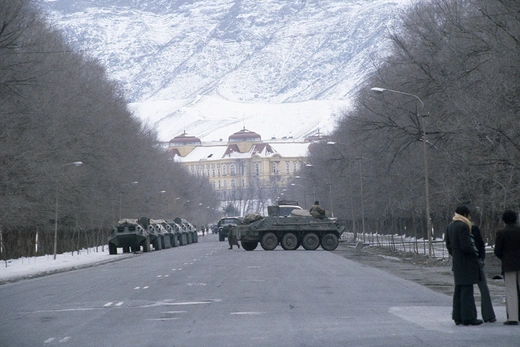
In June 1979, the United States and Soviet Union sign a SALT II agreement that would have placed further limits on their nuclear weapons and launch platforms, including strategic bombers, and imposed certain notification requirements and new testing bans. But in December, the Soviet Union invades Afghanistan, starting a nine-year war in which its forces and allied Afghan communists battle the U.S.-funded mujahideen resistance. U.S. President Jimmy Carter responds to the Soviet invasion by asking the Senate to freeze consideration of the SALT II treaty and by pulling the country out of the 1980 Olympics in Moscow.
‘Zero Option,’ START, and Pershing

In its first year, the Ronald Reagan administration focuses on modernizing the U.S. strategic nuclear arsenal and accelerating a general military buildup. However, in November, President Reagan presents the Soviet Union with a so-called zero option, in which all Soviet and U.S. intermediate-range nuclear missiles would be removed from installations around the world. The following June, Reagan proposes a Strategic Arms Reduction Treaty, or START, which seeks deep cuts in warhead counts and delivery vehicles. Soviet concerns are heightened as the North Atlantic Treaty Organization (NATO) begins to deploy upgraded Pershing missiles in Western Europe, capable of striking targets in Russia. The Pershing II rollout triggers massive antinuclear protests in European NATO states.
Reagan’s ‘Evil Empire’ and ‘Star Wars’ Speeches
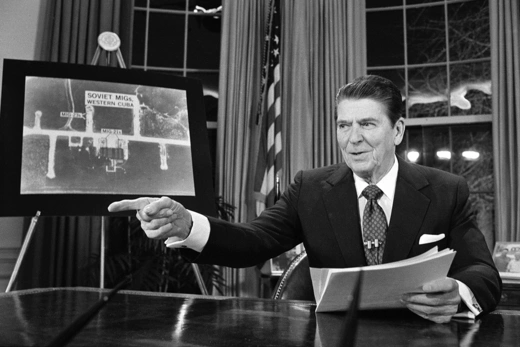
On March 8, President Reagan gives a speech in which he refers to the Soviet Union as an “evil empire,” and warns against “appeasement” and “the so-called nuclear freeze solutions proposed by some.” In a March 23 address, he announces a Strategic Defense Initiative (SDI) to create a space-based ballistic missile shield that could protect against a Soviet nuclear attack. SDI seems to mark a major shift in a U.S. posture that had so far embraced the doctrine of mutually assured destruction, or MAD, to maintain strategic stability. Critics say that the SDI, if technologically viable, would run afoul of the ABM treaty. Meanwhile, the Soviet military grows increasingly wary of a widening technological gap with the West.
Reykjavik Summit
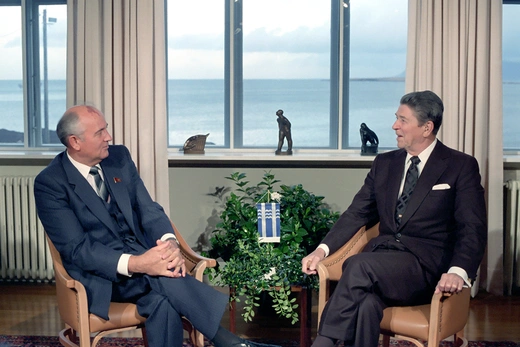
In October 1986, Soviet leader Mikhail Gorbachev and Reagan hold an extraordinary short-notice meeting in Iceland, where the two leaders nearly agree to abolish their offensive nuclear weapons within ten years. (The pair had previously discussed arms control in Geneva, where they declared that “a nuclear war cannot be won and must never be fought.”) The deal unravels over the question of missile defense testing and the SDI research underway in the United States. The Soviets favor a strict interpretation of the ABM treaty that confines research and development to laboratories, while the United States argues for a broad interpretation allowing the development and testing of space-based missile defense technology. Despite their failure to reach an agreement at Reykjavik, the measures discussed pave the way for subsequent nuclear diplomacy.
Intermediate-Range Nuclear Forces Treaty

Gorbachev and Reagan sign the Intermediate-Range Nuclear Forces (INF) Treaty, agreeing to eliminate by 1991 their countries’ arsenals of ground-launched, midrange nuclear missiles (ranging from about 300 to 3,400 miles). It’s the first agreement to reduce nuclear arms—as opposed to setting ceilings—and it introduces comprehensive verification measures. A turning point for the negotiations came after Gorbachev, in a shift from his Reykjavik posture, agreed to de-link the INF from broader strategic talks, which included Soviet efforts to inhibit U.S. development of the SDI.
End of Cold War and START Signed

U.S.-Soviet disarmament talks accelerate after the fall of the Berlin Wall on November 9, 1989, which marks the beginning of the end of the Cold War and communism in Europe. The following year, East and West Germany reunify as one state that retains its NATO membership. In July 1991, with the collapse of the Soviet Union just months away, U.S. President George H.W. Bush and Gorbachev sign the START treaty. The agreement is a success as both sides, which each had more than ten thousand deployed warheads in 1990, pledge to reduce their arsenals to well below six thousand by 2009.
Open Skies and Ex-Soviet Republics Disarm
In March, the United States, newly independent Russia, and twenty-five other countries sign the Treaty on Open Skies, which allows members to conduct scheduled reconnaissance flights over another’s territory. Belarus, Kazakhstan, and Ukraine sign the Lisbon Protocol to the START agreement in May, committing the newly independent states to transferring the former Soviet nuclear arsenals to Russia and to joining the NPT as nonnuclear-weapons states. The U.S. government provides billions of dollars to fund the denuclearization process through its Cooperative Threat Reduction program. The weapons handover is completed by the end of 1996.
START II Signed but Not Implemented
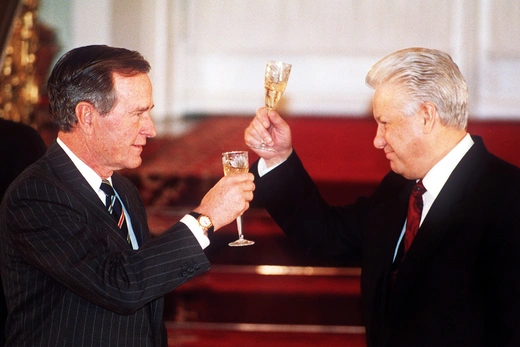
The United States and Russian sign START II, which aims to limit the number of strategic nuclear weapons that the parties can hold to 3,500, respectively. The ratification process, however, would be complicated by many factors and drag on into the next millennium. The treaty never comes into effect.
ABM Treaty Amended
To redefine and strengthen the ABM treaty of 1972, U.S. President Bill Clinton and Russian President Boris Yeltsin ink a joint statement in March that delineates between strategic and nonstrategic, or theater, missile defense systems. Russia ratifies the agreement in 2000, but the measure is never sent to the U.S. Senate. In 2001, President George W. Bush announces that he will withdraw the United States from the ABM, effectively ending the agreement.
Missile Data Sharing Proposal

Building on caveats worked into past arms control agreements, the United States and Russia propose the creation of an early-warning, pre-launch notification system that would reduce the risk of an inadvertent missile launch. The proposal was first floated in 1998 by Yeltsin, who suggested the data-sharing center should be located “on Russian territory.” Washington and Moscow sign a memorandum of agreement on the center in 2000. However, the project is delayed for various reasons, including Russian concerns about U.S. missile defense research, and it never materializes.
SORT and Missile Defense

In May, President Bush and Russian President Vladimir Putin sign the Strategic Offensive Reductions Treaty (SORT), also known as the Moscow Treaty, agreeing to significantly cut the number of deployed strategic nuclear warheads within ten years. Critics say the treaty, which effectively supersedes START II, is too vague and lacks adequate compliance measures. (SORT takes effect the following year after congressional approval.) In June, President Bush withdraws the United States from the ABM, claiming it limits United States’ ability to develop missile defenses against terrorists and so-called rogue states, such as Iran and North Korea. The move angers Russia, which views U.S. foreign policy in the aftermath of 9/11 with increasing concern.
A Missile Shield Fracas
A U.S. plan to place antimissile interceptors in the Czech Republic and Poland irks Moscow, which regards the shield as a threat to its strategic nuclear deterrent. Washington says the system is intended to defend against potential Iranian and North Korean strikes. During Group of Eight (G8) summit talks in Germany in June, Putin proposes jointly developing a missile shield based on radar facilities in southern Russia and Azerbaijan.
The Obama ‘Reset’

President Barack Obama looks to set a new tone for U.S. engagement with the world, giving a series of high-profile foreign policy addresses in Prague, Cairo, and Moscow. He says the United States has a “moral responsibility” to lead the world in nuclear disarmament and pledges to negotiate new strategic weapons reductions with Moscow. As part of this effort, Obama says the United States and Russia should “reset” their relationship so they can focus on common challenges, including nuclear nonproliferation, counterterrorism, and the global economic recession. Later that year, Obama says the United States will alter its Europe-based missile defense system, scratching plans to build permanent sites in the Czech Republic and Poland.
New START
In April, Obama and Russian President Dmitry Medvedev sign a new strategic arms reduction agreement in Prague, replacing the first START treaty, which expired in 2009. The so-called New START treaty commits Washington and Moscow to another round of cuts to their strategic offensive arsenals. The package sets a 30 percent reduction on deployed warheads and lower caps on deployed and non-deployed intercontinental ballistic missile launchers, submarine-launched ballistic missile launchers, and heavy bombers equipped for nuclear weapons. The treaty is approved by the U.S. Senate in a decisive bipartisan vote. The Russian parliament approves it in early 2011.
The Ukraine Crisis
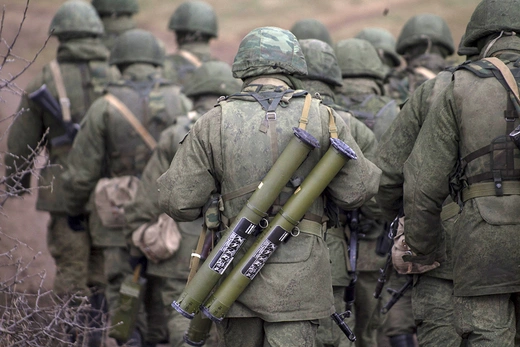
After political upheaval in the former Soviet Republic drives the pro-Russia president from office, Russian security forces invade Crimea, an ethnic Russian–majority region of Ukraine. With its assault on and subsequent annexation of Crimea, Russia violates its previous pledges to respect Ukraine’s territorial integrity, raising deep concerns about its commitments to arms control. Moscow also begins arming and abetting pro-Russia separatists in southeastern Ukraine. The aggression is widely condemned by Western powers, which impose economic sanctions. The United States also supports Ukraine with military aid. The conflict ends the U.S.-Russia reset and heralds a renewed era of geopolitical rivalry.
U.S. Withdraws From INF Treaty
In August, the Donald J. Trump administration announces it will pull the United States from the Cold War–era pact that bans midrange, ground-launched nuclear missiles. For years, the United States had claimed that Russia tested and deployed a cruise missile prohibited by the treaty, an allegation Moscow denied. The U.S. withdrawal, which takes effect in August 2019, is supported by NATO allies and comes amid a series of disputes with Russia over Ukraine, Syria, and interference in U.S. elections.
Open Skies Under Threat

In November, the United States withdraws from the Treaty on Open Skies. As its rationale, the Trump administration alleges that Russia has been abusing the agreement for years. Many NATO members express regret at the U.S. withdrawal from Open Skies, which they say is useful despite Russia’s noncompliance.
New START Extended
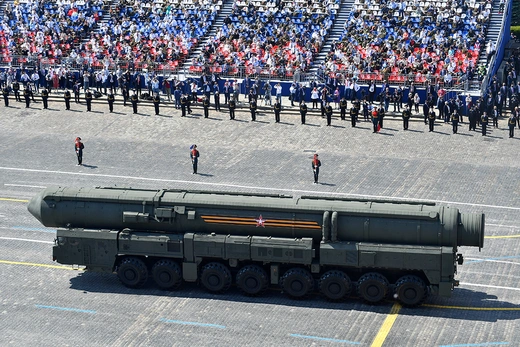
Days before the 2011 treaty is set to expire, the United States and Russia agree to extend New START for another five years, keeping verifiable limits on their arsenals of long-range nuclear weapons. The agreement is one of Joe Biden’s first major foreign policy acts as U.S. president. The Trump administration had tried and failed in its final months to secure a shorter extension to the treaty that would have addressed China’s nuclear weapons.
 Online Store
Online Store